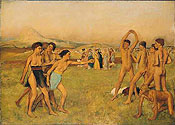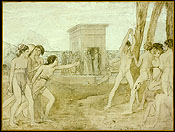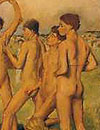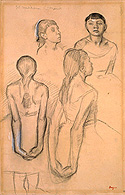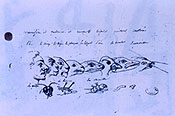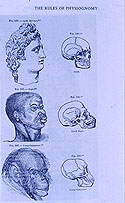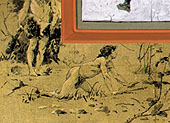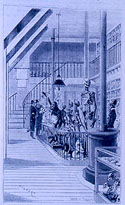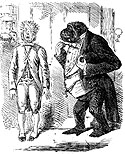The browser will either open the file, download it, or display a dialog.
|
|
Reading the Animal in Degas's Young Spartans |
|||||
| In Edgar Degas's studio a work begun in 1860 sat dormant, unfinished, for almost 20 years. It was a large-scale history painting—one of the few Degas would produce—and it pictured classical figures, linear and abstracted, locked in frieze-like arrangement on either side of a silent space. After seeing the abandoned canvas in the artist's studio in 1879, the Italian art critic Diego Martelli described it as "one of the most classicizing paintings imaginable" and suspected that it remained unfinished precisely for that reason: "Degas could not fossilize himself in a composite past," he explained in a lecture later that year.1 Soon after Martelli's remarks, Degas returned to the painting, removing the classicizing architecture and making several compositional changes. And in one of the most unusual revisions of his career, he painted over the classical profiles, replacing them with distinctly unidealized heads.2 The result was his Young Spartans, now at the National Gallery, London; the painting's original appearance is best approximated by the classicizing grisailles in the Art Institute of Chicago. (figs. 1 & 2) What began as a large-scale history painting in the classical tradition resulted in a betrayal of this tradition, a deliberate painting out of its tropes. It is an act that seems strangely pregnant with meaning and that represents an important moment in Degas's negotiation of the modern body. | ||||||
| Scholarship on Young Spartans has centered primarily on its curious iconography. Degas's notes tell us that the picture represents two groups of adolescents on the plains of Sparta, with the elderly Lycurgus and their mothers in the background. Long thought to be a scene of competition between the sexes, it is now generally regarded as a depiction of ancient courtship rituals, thanks to Carol Salus's careful iconographic study.3 Several details, she tells us, including hairstyle and pose, correspond to descriptions of such rituals found in texts by Plutarch and the French writer Abbé Barthélemy. In her interpretation the gesture of the lunging girl is understood as one of enticement rather than provocation; the apparent crossing over of a male figure to the female side also supports the theme of mating rather than competition.4 However, as Linda Nochlin has suggested, the "meaning" of Young Spartans shouldn't be limited to its iconography; it is a layered, multivalent picture that closes off traditional avenues to meaning, opening up new ones in the process.5 | ||||||
| The revision to the figures is often noted and generally explained as Degas's attempt to "update" his painting. Lemoisne was the first to remark that the figures look more like contemporary Parisians, like the "gamins of Montmartre" than the youth of ancient Greece; more recent scholars have followed suit, the consensus being that the new anatomies appear somehow more "modern."6 This seems an accurate description, but what does it mean, exactly? What are the terms of this modernity? Others have enlisted the revisions in the project of decoding the painting's subject, with the idea that the new anatomies signal some kind of iconographic or metaphoric turn. Norma Broude, for example, interprets the insertion of these "explicitly contemporary Parisian types" as an indication that the subject had assumed a new significance for Degas that must be related to contemporary life. She argues that the picture in its revised version is a metaphor for the equal relationship between the sexes, and that Degas's attitude on this would have changed between his conception of the painting in 1860 and its revision in 1879 or 1880, due to the intervening rise of the French feminist movement.7 | ||||||
| In scholarship addressing the alterations to the body, the visual evidence of the body itself is often relegated to a secondary realm. While the revisions are key to Broude's reading of the painting, they occupy a very tangential place in her argument. Formally speaking, the altered physiognomies are hardly discussed; they serve merely as proof that the subject has a new contemporary relevance. Rather than view the body in Young Spartans as a bridge to a new iconographic reading, the body itself can be understood as the painting's subject, maintaining its narrative role but also producing meanings in addition to those of plot. If Degas's revision yielded a more "modern" body, its modernity resides in its problematization of both the nature of corporeality and the terms of its pictorial representation. It is a problematization that builds its critical foundation on destabilizing principles supplied by evolutionary theory, an emerging discourse that was highly charged during Degas's time, and that offered an account of corporeality that was entirely modern. | ||||||
|
|
||||||
|
II What is striking, first of all, is how centrally animality figures into Degas's reconceived bodies. These Spartan youths are not just unidealized but are aggressively "bestial," their features resembling those of The Little Dancer, which outraged critics called atavistic and monkey-like.8 It is a statement Degas took pains to articulate: heads that were consistently turned away or carefully obstructed by limbs in the original version are now presented in emphatically clear profile, announcing atavistic contours. (fig. 3) To the far right the standing figure's entire position has shifted so that the newly exposed profile stands boldly against the ground of his neighbor's hair, encouraging maximum legibility. The most striking pronouncement of animality, however, is articulated not through anatomy but through pose, in the figure on all fours. It is perhaps a position meant to convey athleticism; indeed, in its original conception the figure's back is slightly rounded, as if stooping down in a racer stance, and his cropped lower half leaves open the possibility that he crouches on one knee. In the final version all ambiguity dissolves, and the figure is fully in view as a quadruped with knees and palms planted squarely on the ground. The back is now flexed, a position that signals animal alertness and base instinct rather than high-minded Spartan physicality. Athleticism has translated into animality, which is underlined by the insertion of a dog in the background group at the same angle and along the same perspective line. (figs. 1 & 2) |
|||||
| Degas revised Young Spartans apparently with the intention of exhibiting it at the fifth Impressionist show in 1880. The painting was never shown, however, and thus there is no critical record to suggest the meanings these new anatomies may have held for contemporary audiences.9 Yet the critical writing pertaining to other of Degas's animalistic figures often invokes the language of science, and specifically evolution. In 1879, Henri Fouquier described Degas's dancers as resembling a "strange beast who descends from the cow, the hippopotamus, and the crocodile, and who would make the Geoffroy Saint-Hilaires of the future dream."10 (Saint-Hilaire was a famous early nineteenth-century evolutionist.) Degas's oeuvre reveals a continual, almost obsessive, play with the signs of animality, a fascination for the ways in which human and animal seem to slide into one another. Bathers and prostitutes scratch and paw at themselves; they are lumbering beings unselfconsciously attending to their bodies and displaying their wares, betraying a sexuality that is base, instinctive, aggressive. Gustave Geffroy remarked in 1886 that Degas depicted women "in animal terms alone, like high-class illustrations for a zoological treatise." The same year Felix Fénéon described one pastel as follows: "Three peasant women, well-proportioned breasts, wade into a river and, their enormous rumps raked by the sun, stroking the air with their simian, half-extended arms. . ."11 | ||||||
|
That this persistent animalizing of human form may be understood in connection with evolutionary theory is often mentioned in passing in the scholarly literature. The connection has been addressed more thoroughly, however, by Anthea Callen in The Spectacular Body, where it is part of a larger discussion concerning the role of contemporary scientific discourse in Degas's work.12 In an opening chapter centering around his sculpture, The Little Dancer, she reveals how the languages of science and medicine, including theories of evolution and degeneration, were absorbed into representation and encoded onto the body. Looking closely at a series of preparatory studies made for the sculpture, she demonstrates how the figure's face and head become increasingly atavistic as the sequence progresses, the end result being "an emphatically primitive cranium."13 Callen focuses especially on a black-chalk drawing in which the head is rendered from four different angles: a sketch at top left seems to be a study in atavism of the lower face, while that at top right reveals an asymmetrical skull shape that is "indicative of excess development of the animal hemispheres of the brain."14 (fig. 4) | |||||
| Callen discusses evolution as one of several closely interwoven scientific and pseudoscientific discourses of the time—phrenology, physiognomy, comparative anatomy, and anthropology—that shared an obsession with constituting the body as a legible text. Animalistic anatomy and atavistic skull type were indications of a person's low ranking on the evolutionary scale; from this, conclusions about his or her innate criminality, predisposition toward vice, or generally low social ranking could be inferred. It was a complex signifying system in which separate signs reverberated endlessly back and forth and were bound up in one another: animality signified criminality signified lower evolutionary state. This expressive potential lodged in the discourse of science supplied artists with "a new vocabulary of visual signs to modernize conventional pictorial codes and give art new representational powers."15 | ||||||
| While animal forms had long been a staple of physiognomic theory, appearing most famously in the work of Charles LeBrun in the late 17th century, its goal was largely metaphoric: the subject was thought to possess the characteristics of the animal he or she resembled. In the Darwinian era, however, the animal sign took on new and distinct meanings, serving in representation as an index to a subject's position on the evolutionary ladder, and moreover, to social status. In the Little Dancer, therefore, Callen explains that Degas "made explicit use of images current in science and medicine to make his figure instantly recognizable as a member of the so-called classes dangereuses."16 Elsewhere she suggests that he was "consciously exploring monkey and other animal physiognomies as scientific signifiers of low class Parisiennes at this period."17 The critical reaction to the sculpture certainly supports her argument. Several reviewers noted the figure's "animal forehead and jaws," which they read as markers of her deviance. | ||||||
|
|
||||||
| Douglas Druick has also discussed how the discourses of science informed both the production and reception of the Little Dancer. Arguing that Degas intentionally coded the figure as morally deviant, he frames the sculpture in relation to other works bearing similar animalistic physiognomies and describes how those works were constructed and interpreted as degenerate, less evolved types. He focuses on the sculpture's pairing at the 1881 Impressionist show with Criminal Physiognomies, two pastel portraits picturing markedly atavistic profiles, and which in title alone clearly revealed Degas's subscription to the popular idea that criminality was biologically predetermined and physically legible.18 Extending his discussion to the liberal use of the animal sign in the brothel monotypes, he adds that "the artist had relied on the predictability and prejudice of physiognomic codes and stereotypes, endowing the brothels' inhabitants with caricatured faces that. . .underscore their animal—and potentially criminal—natures."19 | ||||||
| The intimate relationship between art, science and modernity in the late 19th century that both authors illuminate is crucial for understanding Degas's work. Callen's discussion moves fluidly between the discourses of evolution, anthropology, criminology and physiognomy, evoking a sense of their continual overlapping. Yet this interweaving that so skillfully evokes the complexity of the scientific climate also has a kind of leveling effect: evolution becomes too easily swept up under the broader cultural phenomenon of physiognomy, and is seen only as a buttress to the bourgeois classification systems already in place. Degas's interest in physiognomy is well known and occupies a central place in his work, but was his only goal to make his subjects "instantly recognizable as a member of the so-called classes dangereuses"? Was Darwinian theory so readily and optimistically absorbed that it served only to reassure the bourgeois viewer of his privileged place on the evolutionary scale? While the animal/evolutionary sign undoubtedly served as an immediate signifier of class and social type, to circumscribe its role to one of expressivity is to foreclose the other ways it might have operated within Degas's practice. | ||||||
| The limits of this "social type" interpretation reveal themselves upon considering Young Spartans. If animality is indeed a signifier of the classes dangereuses, how then do we explain its presence on the bodies of ancient Greek youths? Certainly Degas didn't mean to suggest that ancient Greeks were immoral, or lower on the evolutionary scale, or criminal types. Animality in this picture does not easily settle into its physiognomic role; it is strangely—insistently—out of order, chafing against its classical backdrop. Interestingly, Callen does not discuss Young Spartans. The painting contains one of Degas's boldest assertions of the atavistic type and yet she omits it from her broad-ranging study of Degas's scientifically-informed physiognomic project, for reasons we can only assume have to do with its refusal to fit into her argument.20 | ||||||
| What I am suggesting is that within Degas's work the animal sign must be understood in connection to evolutionary theory, but that to view it only as a physiognomic marker with specific evolutionary resonances is to overlook the more disruptive effects of its inscription on the human body. The animal sign is first and foremost an anxious sign; its persistent assignment to the body of the other is an indication of its danger. What it signals, even as it codifies a specific type, is a radically different conception of human form. The animal sign operates simultaneously in two different registers, and to two different effects: in the social sphere, it enables legibility; but in the sphere of the psychological and subjective, it confounds and disturbs, producing a fracturing of stable meaning and subjectivity. The animal sign is loaded with critical potential, and it is only when it strays from the context of the modern body, when its physiognomic operation is short-circuited as it is in Young Spartans, that this critical potential moves into the foreground. | ||||||
| III. The more destabilizing operation of the animal sign arises from the same place that it derives its efficacy as a codifier in the social sphere: the ambiguous zone between man and animal. While an animalistic body could serve as a reassuring index to a person's inner character, it could also produce other, more troubling significances in this new era marked by the rise of Darwinism. What needs to be addressed first is Darwinism's reception among nineteenth-century audiences. Most art historical accounts suggest that evolutionary theory was immediately embraced by a bourgeoisie who viewed it as a march toward progress, or as scientific justification for hierarchies already in place.21 Yet even as it was recruited into the project of cultural and racial hegemony, Darwinism remained a deeply disruptive idea: it introduced the troubling notion of corporeal instability into public consciousness, displacing long-held assumptions about the permanence of human form. |
||||||
| In The Origin of Species, translated into French in 1862, Darwin challenged the long-held definition of species as fixed, individual units, whose forms were intact and eternal. In his view, living organisms were not immutable but constantly in flux, always in the process of transformation. Moreover, Darwin asserted that the naming of organisms into species was perfectly arbitrary; the term was a mere construct invented for the purposes of organization. The notion that species were ever-changing meant that the lines demarcating individual organisms could no longer be easily drawn, an idea that produced considerable anxiety among French audiences.22 As Pierre Flourens, one of evolution's most vocal opponents, described it in his 1864 Examen du Livre de M. Darwin: "We all know that species do not change . . . and yet a man arrives . . . a Monsieur Darwin, who tells us that species do change . . . And already I see a certain public, at first astounded, then stupefied."23 It was precisely the impossibility of demarcating the limits of form—of discerning the body's beginning and end—that propelled the anxiety behind August Laugel's 1860 review of The Origin of Species. "Classification," he writes, "is the thread that guides us through the labyrinth of nature; but. . .our divisions are only the forms that the mind fashions at will, in order to organize the shreds of truth that it is able to grasp."24 The writer grapples throughout his review with the unsettling notion: categories are arbitrary, the mere product of representation, the exponent of our desire. | ||||||
|
J.-J. Grandville's Transition of the facial angle from man to caterpillar seems to translate this idea into visual form.25 (fig. 5) The drawing is not merely an exposition of man's structural likeness to other creatures in the tradition of comparative anatomy illustration but also a chart of the corporeal slippage that defines evolution. Figures are crammed together in a continuous space, overlapping, implying one fluid organism stretched out over time. Even the captions read like one sentence with words flowing together. If physiognomy operates through a controlling, mastering gaze that suppresses the arbitrary and organizes its objects into a readable hierarchy, then evolutionary theory undermines that gaze, confounding legibility and classification, disrupting traditional channels of meaning. If physiognomy is based on the concept of metaphor, then evolution is based on that of metonymy; the body is always not quite what it will be. | |||||
| Evolution, then, may be understood as a discourse on boundaries, one that rendered the corporeal frame a site of particular anxiety during the late nineteenth century. Degas's inscription of the animal sign onto his Spartan bodies directly engages the newly jeopardized status of the corporeal frame: its presence signals the breaking down of borders that had been constructed as impenetrable in the history of Western art and science. Degas gives us anatomies that slip, slightly, off their classical frames and that stand instead at the edge of categories. He gives us bodies that speak of indeterminacy and ambiguity, and this is precisely the source of their danger. | ||||||
| IV. It is this precarious state of the in-between around which Julia Kristeva builds her formulation of the "abject." In this definition the "abject" refers to an intermediate category of objects that induce loathing, disgust, and repulsion, not because of their inherently repulsive properties, but because of their transitional states; bodily fluids and waste are abject because they traverse corporeal boundaries and cannot be properly categorized as either part of the interior or exterior of the body. Abjection, for Kristeva, is "what disturbs identity, system, order. What does not respect borders, rules. The in-between, the ambiguous, the composite."26 It is that which does not fit neatly into oppositions; or as Elizabeth Grosz explains, that which "necessarily partakes of both polarized forms but cannot be clearly identified with either."27 The evolutionary body, always at the edge of categories, signals a site of possible danger and repulsion. It is an abject body, borderless and forever between states. |
||||||
|
Kristeva's notion of the abject draws upon the work of Mary Douglas, who has discussed the ways in which society defends against elements that resist clear-cut classification. Focusing on the societal constructs of purity and pollution, she defines "dirt" as that which is out of order, as "matter out of place"—like Kristeva, locating danger in transitional states.28 The related condition of "purity" is theorized as society's attempt to organize the ambiguous: "Our pollution behavior is the reaction which condemns any object or idea likely to confuse or contradict cherished classifications."29 For Douglas, boundaries are critical in the maintenance of social order: "Ideas about separating, purifying, demarcating and punishing transgressions have as their main function to impose system on an inherently untidy experience. It is only by exaggerating the difference between within and without, above and below, male and female, with and against, that a semblance of order is created."30 We might understand the persistent assignment of animality to the sexually deviant female body in Degas's work as a kind of "tidying up" of the mess of evolutionary theory, its location on the body of the other a means of containing evolution's threat to corporeal integrity. Such a strategy was prevalent in 19th-century visual culture and is nowhere more evident than in Nott and Gliddon's The heads and skulls of Apollo, a negro and a chimpanzee compared. (fig. 6) Unlike Grandville's drawing, this image makes no suggestion of corporeal slippage; on the contrary, borders are fixed, unassailable. It is a juxtaposition that aims to rid the European body of animal associations, collecting and neatly depositing them into the body of the African. What we have, in other words, is an erecting of racial and cultural boundaries that occurs with the dissolution of corporeal ones. | |||||
| In Young Spartans the animal sign is neither safely locked away onto the female body nor presented in clear-cut opposition to human. It spills over, undiscriminating, onto all figures in the painting, and it is this "pollution" of the human frame that most directly signifies Degas's engagement with evolutionary theory and its flippant disregard for the limits of form. This primary disavowal of bodily integrity is reiterated in smaller pictorial episodes throughout the painting. The female side is a study in somatic uncertainty: it presents a flurry of legs that fail to match up with bodies, and as Nochlin has noted, the embracing couple in the background seems to "merge pictorially into a monstrous whole, a kind of proto-Picassoid integration of profile and full face that is disconcerting rather than reassuring in the context of 19th-century realism."31 However, it is on the male side where the threat of evolutionary ambiguity is most poignantly articulated, despite the appearance of five distinct, intact bodies. | ||||||
| The male side can be read as one body repeated five times. It is often noted that the male and female groups stand in strange isolation from one another, separated by an empty, unbridgeable space. It is an arrangement that has generated interesting discussions about Degas's attitude toward gender and the relation between the sexes.32 However, we might also look at how this compositional apartheid seems to nominate each group as a self-contained entity, as a study in and of itself. (Self-containment is also suggested by the introduction in the revised version of a stretch of empty space behind the male group, cutting off the possibility that they are part of a larger configuration). If we read the male figures as five points in the trajectory of one body, then, moving from foreground to background, we see how each figure seems to be the logical successor to the one in front of it, almost a Muybridgean study of the figure on all fours in the process of standing up. The more muddled organization in the original version has given way to a clear demarcation of the figures in space so that their position in the sequence is easily comprehended: note that one of the figures in the grisailles, present only as a head, has been removed. A trail of hands leads the eye diagonally upward and backward; the contracted leg of the middle figure gradually extends; the position of the arms shifts from an emphatic downward directional, moving with each figure toward its highest vertical extension. The effect is of one body stretched out, as figures overlap in the manner of Grandville's illustration of formal fluidity. | ||||||
|
What is striking is that it is a body anchored, on either end, by opposites: man at his most vertical and most horizontal. Degas was fixated on these two figures, devoting more time to them than to any others, producing numerous preparatory drawings. Interestingly, these are poses that held enormous significance within the evolutionary literature. Opponents of evolution summoned modern man's upright position as irrefutable evidence of his separateness from animals, of the absolute morphological gulf between man and ape. Paul Topinard, for example, in L'Homme dans la nature of 1891, refuted the blurring of lines between human and animal: he argued that man is the only true bimane, and because of this fact, categorically speaking "he should remain isolated, above the anthropoids and apes."33 The human/vertical vs. animal/horizontal binary was forcefully asserted in an urgent marking of boundaries where they were in danger of eroding. On the other side, evolutionists chipped away at the fiction of man's eternally vertical stance, imagining our ancestors as earth-bound and horizontal. Within the new pictorial genre of scenes of prehistoric life, the intermediary state of prehistoric man was often signified through the quadruped pose, as in Paul Jamin's La fuite devant un mammouth. (fig. 7) | |||||
| In his opposing male figures Degas seems to deliberately conjure up iconic stances in the evolutionary debate. Yet by collapsing these two poles of human erectness and animal baseness into one species, he effectively levels their difference, undermining the crucial binary asserted by Topinard. It is tempting, then, to read the male group as a sort of "narrative" about one body's evolutionary progress—a chronicle of man's triumph over his originally horizontal/animal state. Yet I think this is not quite right. For in Young Spartans the vertical has no privilege. It is always countered by the horizontal; the painting seems to pivot on the tension between these two axes, as in the silent clash between the stretching male figure and the long, horizontal reach of the lunging girl. The presence of two opposing states in the male group suggests a body caught in between, unable to claim either position: what is vertical is also horizontal, what is human is also animal. The male cluster diagrams not the story of evolution, but rather the condition of corporeality in an evolutionary universe—an abject corporeality that knows no limits and is always between categories, that "necessarily partakes of both polarized forms but cannot be clearly identified with either." | ||||||
|
The evolutionary abject is particularly apparent in works like Degas's 1876–77 monotype, Woman in the Bath. (fig. 8) It is a familiar subject—a woman engaged in the act of bathing—made strange by the animal rumbling beneath the surface. An unmistakably atavistic profile, with receding forehead and protruding snout, declares itself against the stark white of the tub. The highlighted hand curls into a claw-like form, suggesting a creature scratching itself rather than washing. The figure's head projects forward, while her hunched shoulder, mimicked by the swelling curve of the tub, suggests Neanderthal.34 We are left with a categorical uncertainty, an illegibility that seems to translate into an overall dissolution of form, as the figure dissolves into the ground of the murky water. The competing contours of human and animal continually confound each other so that neither is figured. They are opposing forces, canceling each other out, producing an intermediary body that, despite its specific setting and implied social class, cannot properly signify. | |||||
| Young Spartans, too, enacts a kind of semiotic failure that seems partly the product of evolutionary indeterminacy. The painting is famous for its refusal to signify, a quality its blank center seems to emblematize and that is the source of the interpretive difficulties surrounding its subject matter. Nochlin has argued that this illegibility is hardly a failure on Degas's part, but that the artist deliberately creates ambiguities, throwing up barriers that work against his iconography. She points to several places where compositional arrangements and especially ambiguous gestures render the subject uncertain, a strategy that ultimately undermines "the very notion of meaning in history painting as a genre."35 Yet the painting's disruption of meaning is performed not just through the ambiguous actions of the body on its surroundings, but at a more inward level: our apprehension is frustrated by the body's resistance to the human contours it seems to claim for itself. | ||||||
|
V. That Degas would have brought evolutionary principles to his reconceived Young Spartans seems especially likely when we consider that the revisions were made during two of the most crucial years for the absorption of Darwinian ideas into public consciousness in Paris. In 1878, the Société d'Anthropologie, a bastion of evolutionary thought, presented animal and human anatomies in striking comparisons at the new anthropology museum.36 (fig. 9) That same year at the Exposition Universelle, held in Paris, the Société presented a dizzying array of prehistoric tools and over 1,400 skulls and bone fragments, arranged with a distinct evolutionary message. In one room, human and ape skeletons were presented, disconcertingly, side by side. As one reviewer described it, "The public was face to face with these skeletons and brains and skulls of men and apes, and they were struck by the analogies. Imagine the innumerable reflections that these objects raised, the questions they provoked!"37 The analogies were striking enough to prompt another outraged writer to title his piece "Le Darwinisme à L'Exposition Universelle." He described the notion of an intermediary between man and ape as "nauseating"—a "pollution" of the human form.38 |
|||||
| The following year, 1879, marked the discovery of prehistoric cave paintings at Altamira, which, on top of recent Neanderthal and Cro-Magnon findings, provided further evidence for the possibility of man's ancient existence. Evolutionary ideas were increasingly fashionable in Parisian intellectual circles, including that of Degas. The critic Edmond Duranty brought Darwinian ideas to a rather eccentric interpretation of figural paintings in the Louvre; Berthe Morisot wrote of Darwin in letters; and Degas's good friend Ludovic Lepic was an avid student of prehistoric times, reconstructing ancient tools for the newly opened Musée des Antiquités Nationales in nearby St.Germain-en-Laye.39 Degas himself was always interested in the latest scientific currents and read the popular science journal La Nature, which frequently featured articles on evolutionism and prehistory.40 | ||||||
|
Furthermore, it was between 1878 and 1879 that the Salon painter Fernand Cormon began sketching out a monumental painting with an unmistakably evolutionary tenor: the controversial Cain Fleeing with his Family, in which figures from the biblical story were recast as a tribe of prehistoric cavemen, complete with animal pelts, prehistoric tools, and distinctly atavistic anatomies. (fig. 10) The painting would be the sensation of the 1880 Salon, as much for its thrilling presentation of prehistoric life as for its controversial, scientifically-informed treatment of the human body.41 With the exhibition of this work, Darwinism and its sign entered the official arena of art as well as the critical discourse; reviewers were outraged by bodies they perceived as "filthy, boorish, bony, intermediaries between man and beast (italics mine)."42 Another chastised the artist for giving visual expression to "the ideas of the most adventurous disciples of Darwin."43 Degas surely would have seen the picture at the 1880 Salon, and it is likely that the two artists discussed Cormon's project the previous year, at the Café de la Rouchefoucauld, where they were both regulars.44 While we can't know for sure if Degas had Cormon's painting in mind at the moment of his revision to Young Spartans, certain parallels are hard to ignore. Cain, too, was a history painting on a grand scale devoted to the nude. It, too, was a work that problematized traditional conceptions of the human body, redrawing its boundaries, and that did so under the sign of the animal. | |||||
|
The objection to Cormon's "intermediary" figures points to this fear of the uncategorizable body that marked the evolutionary era. But what, exactly, is the source of this fear, this nausea? Following Douglas's theory, such an intermediary body would have posed a threat to social systems. Indeed, this idea seems to be subject of a famous cartoon of 1861 from the British magazine, Punch, where the ultimate danger of evolutionary theory is expressed as an overturning of social order. (fig. 11) The horrified gentleman bristles not merely at the suggestion of man's undignified origins, but at the shock of seeing this emblem of undignified origins dressed up as a refined British gentleman. The fragile veneer of civilization is exposed; the ease with which the gorilla assumes the attire of the upper class suggests the frailty of such artificial social boundaries in the face of evolution's slippery slope. The cartoon is about the traversing of boundaries, corporeal and social, and its humor and shock derives precisely from the animal sign's location: it appears more out of place here than in a brothel. | |||||
| Yet despite the obvious class anxiety that the concept of evolution introduced, the threat of the boundless, intermediary body resides more at the psychological than societal level. If the Punch cartoon addresses the horror of the animalized human in terms of its threat to social order, it also locates its horror in threat to the status of the self. The unwelcome guest suggests the appalled gentleman's own animality. This beast in similar attire is his mirror image; his repulsion is a product of the collapse of boundaries between self and other. The gorilla in this cartoon represents the emergence of something the ego wishes to represses: man's abject state, which by virtue of its in-betweenness destabilizes not just the boundaries of the body, but the boundaries of the self. | ||||||
| While Douglas's interest is in the social significance of corporeal boundaries, Kristeva finds their primary significance in their role in the constitution of the subject. Drawing on psychoanalytic models in which the ego is conceived of not as a disembodied psychical entity but rather as determined by corporeality and its limits, she argues that an awareness of the distinctions between inside and outside of the body are what constitute the subject, giving it a sense of autonomy and self-identity. When bodily fluids traverse corporeal boundaries, they adumbrate the subject's potential to collapse into the outside from which it struggles to distinguish itself. If, as Kristeva theorizes, stable subjectivity depends on the image of one's own body as with fixed corporeal limits, then the body as it is conceived of in evolutionary terms fails to provide this image. Fluid, edgeless, forever in formation, the evolutionary body by definition can never be regarded as a distinct, proper entity. The mark of this body, written onto the Bather and even more strangely onto Spartan youths, suggest a troubling failure of form, a resistance to closure which ultimately threatened disruption to the notion of a stable, unified, self. As the body's limits cannot be determined, the self cannot be mapped. | ||||||
| VI. What makes Degas's revision of Young Spartans so interesting, finally, is what it eliminates. The base onto which the animal mark is inscribed was hardly a neutral one. During the Darwinian era, the classical body was actively constituted as the evolutionary body's antithesis. Nott and Gliddon's drawing, in which the head of Apollo is positioned as the ape's opposite, is just one of many 19th-century articulations of this dynamic. Such imagery suggests that the classical body's role in the evolutionary era was first of all cultural, claiming ancient Greece as European man's true origins and simultaneously positioning Western culture at the top of the evolutionary hierarchy. |
||||||
| But what the classical tradition also represented during the evolutionary era was pure, unvarying form. If the evolutionary body suggests the absence of boundaries, the failure of form, the classical body is the icon of invariability. Characterized by the finitude of its formal contours, it presents the body as a closed system with clearly defined limits—a promise of stable boundaries and unified subjectivity. It emblematized everything that was human, rational, and vertical: the antithesis of animality. Indeed, classical canons of art were often called upon to decry notions of corporeal variability increasingly asserted by anthropologists. Topinard, for example, in L'homme dans la nature, differentiates between classical and anthropological canons of the body and the limits of form that each intones: "Art by nature is idealist, unitary; it permits only one canon, only one human type. . .while that of anthropology, necessarily realist, accepts multiple types and multiple canons."45 | ||||||
| If the classical figures in Degas's original conception of Young Spartans may be understood as a fantasy of wholeness in body and self, then it is this fantasy that is shattered in his revision. The painting positions itself within the classical tradition and then proceeds to retract its promises, breaking down crucial oppositions between man and animal, mind and body, civilized and primitive. But most significantly, it enacts a dismantling of secure classical form, and with it, the conception of corporeality it implicitly upheld. Degas used the principles of evolutionary theory to take apart the classical body from within. The stretching figure emblematizes the presence of form and secure boundaries embodied by the classical tradition—vertical, resilient, he is almost Vitruvian man—and the inclusion of this figure's base, horizontal opposite may be understood as form's undoing. Indeed, for Rosalind Krauss, horizontality is a primary expression of the formless.46 In Grandville's drawing, as well, we see that the conclusion of form's unraveling is an emblem of horizontality: the legless, ground-hugging caterpillar. | ||||||
| If the classical body is a repression of man's baseness, then the evolutionary body is a return of that which has been repressed. And if the classical nude represents pure form, intellect, rationality—a Cartesian rejection of the corporeal—then the evolutionary body figures the subject as hopelessly bound to his corporeality. What Degas seems to have staged in his revision is subjectivity not merely destabilized, but reconstituted as purely corporeal. He exchanges form for its base other, displacing the ideal with an evolutionary, and altogether modern, body. | ||||||
|
1. Cited in Norma Broude, "Edgar Degas and French Feminism, ca. 1880: 'The Young Spartans,' the Brothel Monotypes, and the Bathers Revisited" Art Bulletin 70 (December 1988), p. 642. 2. I am working from Broude's dating of the revision, which she convincingly places between 1879 or 1880 rather than the mid-1860s, as has also been suggested. Broude's chronology is based on a reference to the painting in a lecture by Diego Martelli. Martelli had seen Young Spartans in Degas's studio at some point during his sojourn in Paris from April 1878 to April 1879, and in his lecture in 1879 described it as "one of the most classicizing paintings imaginable." Broude reasons that "at the time Martelli saw the picture, Degas had not yet carried out the major modifications that X-ray examination of the canvas in its present state has revealed—that is to say, the alteration of the figures from their original classicizing models to the more obviously contemporary types that we see here." Broude 1988, p. 642. 3.Carol Salus, "Degas's Young Spartans Exercising" Art Bulletin 67 (September 1985), pp. 501-06. 4. Other details such as hairstyle support this interpretation. Salus argues that the lunging figure's cropped hair seems to follow Plutarch's description of Spartan girls having shorter hair following marriage. Degas has adopted it to his own ends, however: here cropped hair means the figure is ready for marriage. 5. See Linda Nochlin, "Degas's Young Spartans Exercising" Art Bulletin (September 1986) 68, 486-488. 6. See P-A. Lemoisne, Degas et son oeuvre, vol. 1 (Paris, 1946-9) p. 42. Douglas Druick suggests that "they appear more like contemporary Parisians than antique statuary." See Douglas Druick in "Framing The Little Dancer Aged Fourteen" in Richard Kendall, Degas and the Little Dancer (New Haven: Yale University Press, 1988), p. 93. Henri Loyrette similarly describes the new features as the "commonplace faces of the children of the streets of Paris." Loyrette, in Jean Sutherland Boggs et. al. Degas (Paris, Ottawa, New York, 1988), cat. 40. 7. See Broude, "Edgar Degas and French Feminism." 8. Druick notes the resemblance between their features and the "much discussed 'bestial mugs' reviewers discerned in Little Dancer and in the Criminal Physiognomies." Druick 1988, p. 94. 9.The painting was included in the catalogue for the 1880 Impressionist show as no. 33, "Petites filles spartiates provoquant des garçons (1860)." Several critics noted its absence in their reviews of the exhibition. 10. Cited in Carol Armstrong, Odd Man Out: Readings of the Work and Reputation of Edgar Degas (University of Chicago Press, 1991), p. 43. 11. Cited in Richard Thomson, Degas: The Nudes (New York and London: Thames and Hudson, 1988). The use of animal analogies so common in the critical writing of the time continues in the scholarship today. Regarding a group of bather pastels probably from the 1890s, Jean Sutherland Boggs writes, "The sheer animality of their pleasure seems underlined by the ghostly presence of a faint red cow in one large pastel. . ." Boggs, 346-350. Theodore Reff, describing At the Café-Concert, notes the "animality of their performers and their audience." Theodore Reff, Degas: The Artist's Mind (New York: Metropolitan Museum of Art, 1976), p. 34. 12. See A. Callen, The Spectacular Body: Science, Method and Meaning in the Work of Degas (New Haven: Yale University Press, 1995). In other discussions the relationship between bestial figure types and evolutionary theory is implied rather than stated directly. Thomson, for example, describes Degas's prostitutes in the brothel monotypes as "bestial, keyed up for sex, beyond the bounds of decency," adding that "they are shown as women of a baser race." Thomson 1988, p. 117. 13. Callen 1995, p. 22. 14. Callen 1995, p. 22. 15. Callen 1995, p. 3. 16. Callen 1995, p. 1. 17. Callen 1995, p. 22. 18. See Druick 1988. By exhibiting these works together in the same room, Druick argues, Degas invited comparison between their atavistic anatomies and was perhaps making a moral statement about the degeneration of the French race. 19. Druick 1988, p. 92. 20. Druick, on the other hand, does discuss Young Spartans. He reasons that had the painting been included in the 1880 show (as was originally intended), its strong, healthy Spartan protagonists would have functioned as an example of the good effects of environment on the prosperity of the race, especially when set against Criminal Physiognomies. See Druick 1988. 21. Bram Dijkstra, for example, calls evolutionary theory a "resplendent white knight in the service of discrimination." See his chapter "Evolution and the Brain" in Idols of Perversity: Fantasies of Feminine Evil in Fin-de-Siècle Culture (Oxford University Press, 1986). 22. Thomas Huxley carried Darwin's arguments even farther. Far from constituting a separate order, man was, from a zoological point of view, a primate. His Evidence as to Man's Place in Nature (London, 1863) was translated into French and included diagrams in which the profile of a modern skull was superimposed onto that of prehistoric man to reveal a shift in form; such diagrams were icons of evolutionism and succinctly expressed the fiction of corporeal permanence. 23. Cited in T. Appel, The Cuvier-Geoffroy Debate: French Biology in the Decades Before Darwin (Oxford University Press, 1987), p. 233. On the reception of Darwin in France see George Stebbins, "France" in The Comparative Reception of Darwinism, ed. T. Glick (Chicago: University of Chicago Press, 1988); Yvette Conry, L'introduction du Darwinisme en France aux XIXe siècle (Paris: J. Vrin, 1974); and C. Grimoult, Evolutionnisme et fixisme en France: Histoire d'un combat, 1800–1882 (Paris, 1998). 24. August Laugel, "Nouvelle Théorie d'Histoire Naturelle: L'Origine des Espèces" Revue des Deux Mondes (April 1, 1860) p. 645. Laugel's review was written two years before The Origin of Species was translated into French, by Clemence Royer, in 1862. 25. Grandville's drawing was produced years before Darwin's theories emerged, and is more a reflection of Jean-Baptiste Lamarck's earlier evolutionist theories. Though Lamarck is now regarded by the French as the father of evolutionism, during his own time his theories were largely dismissed by the scientific community. It wasn't until Darwin's publication, which provided a theory as to how transformism occurred, that evolutionism made a real impact in the European scientific community and with the general public. 26. Julia Kristeva, Powers of Horror: An Essay on Abjection, (New York: Columbia University Press, 1982), p. 4. 27. E. Grosz, Volatile Bodies: Toward a Corporeal Feminism (Bloomington and Indianapolis: Indiana University Press, 1994) p. 192. 28. "Dirt is only dirt in certain contexts," she writes. "Shoes are not dirty in themselves, but it is dirty to place them on the dining table; food is not dirty in itself, but it is dirty to leave cooking utensils in the bedroom." M. Douglas, Purity and Danger: An Analysis of Concepts of Pollution and Taboo (New York and Washington: Praeger Publishers, 1966). A discussion of Douglas's influence on Kristeva's conception of the abject can be found in Grosz, Volatile Bodies, pp. 193-195; see also Grosz's essay "The Body of Signification" in Abjection, Melancholia and Love: The Work of Julia Kristeva, ed. John Fletcher & Andrew Benjamin (London & New York: Routledge, 1990). 29. Douglas 1966, p. 35. 30. Douglas 1966, p. 4. 31. Nochlin 1986, p. 487. 32. Nochlin 1986 and Broude 1988 33. "Il doit rester isolé, au-dessus des anthropoïdes et des singes. . ." Paul Topinard, L'homme dans la nature (Paris, 1891), p. 338. 34. Richard Thomson has suggested that the less-than-ideal appearance of the bather owes simply to the difficult nature of the medium. He reasons that with these dark-field monotypes "Degas had no time for anatomical nicety, for genuflection to the traditional ideal of the female nude." (Thomson 1988, p. 78). But the anatomical distortions seem too intentional to chalk up to a recalcitrant medium; the boundary between leg and arm, for example, is literally rubbed out by the artist's thumbprint in a deliberate blurring of corporeal legibility. 35. Nochlin 1986, p. 487. 36. The Société d'Anthropologie was founded in 1859 by Paul Broca. Because of its frequent exhibitions and publications, the Société was an important vehicle in the diffusion of evolutionary thought among the French scientific community and the general public. On Paul Broca and the Société see Francis Schiller, Paul Broca: Founder of French Anthropology, Explorer of the Brain (University of California Press, 1979). 37. "Le public voyait face à face des squelettes, des cerveaux, des crânes, d'hommes et de singes. Vous vous doutez des réflexions sans nombre que soulevaient ces objects, des questions qu'ils povoquaient!" H.-M. Vincent, L'Homme et le Singe à l'Exposition Universelle (1878), Section d'Anthropologie (Nimes, 1879), pp. 5-6. 38. See Constantine James, "Le Darwinisme à L'Exposition Universelle" in his Moïse et Darwin. L'homme de la Genèse comparé a l'Homme-singe (Paris, n.d.) p. 414. 39. Druick tells us that Morisot wrote in a letter that she was reading Darwin. Druick 1988, p. 183, fn 35. Duranty's piece, in which he discusses the evolution of gesture using a Darwinian model, was titled "Promenades au Louvre " Gazette des Beaux-Arts (January, 1877). On Ludovic Lepic, his interest in prehistoric archaeology, and his work at the Musée des Antiquités Nationales, see Harvey Buchanan, "Edgar Degas and Ludovic Lepic: An Impressionist Friendship" Cleveland Studies in the History of Art, vol. 2 (1997), pp. 32-120. 40. On Degas's interest in science see Callen 1995. See also Douglas Druick and Peter Zegers, "Scientific Realism, 1873–1881" in Boggs 1988. They write, "Degas, like his friend the writer Edmond Duranty, believed that modern art should aim to create images of modern life informed by the findings of science." 41. For a discussion of Cormon's controversial painting in the context of the evolutionary discourse, see M. Lucy, "Cormon's 'Cain' and the Problem of the Prehistoric Body" Oxford Art Journal 25 (Autumn 2002), pp. 107-126. See also Geneviève Lacambre, "Le Caïn de Cormon" in Gloire de Victor Hugo (Paris: Grand Palais, 1985), pp. 625-7. 42. "Il est donc tenté de les faires sordides, énormes, grossiers, intermédiaires entre l'homme et la brute." E. About, "Salon de 1880," Le XIXe Siècle, 18-19, May 1880. 43. "Il a voulu soutenir à sa manière les idées des disciples les plus adventureux de Darwin." C. Clément, "Exposition de 1880," Journal des débats, 1 May 1880. 44. Sophie Monneret writes that Cormon was a regular at the Café de La Rouchefoucauld, like Degas, "avec lequel il aimait discuter." See S. Monneret, L'Impressionisme et son époque, vol. 1 (Paris, 1978). Degas's frequent presence at the café during those years is confirmed in his 1879 letter to Bracquemond: "Je déjeuner tous le jours (à rares exceptions près) au café de la Rouchefoucauld, devant le petit marché, au coin de la rue Notre Dame de Lorette et de la rue de la Rouchefoucauld." See Marcel Guérin, ed. Lettres de Degas, (Paris, 1931), p. 45. 45. "L'art de sa nature est idéaliste, unitaire; il n'admet qu'un canon, qu'un type humain. . .tandis que l'anthropologie, nécessairement réaliste, accepte des types et des canons multiples." Topinard 1891, p. 125. 46. See Rosalind Krauss, "Horizontality" in Yves-Alain Bois & Rosalind Krauss, Formless: A User's Guide (New York: Zone Books, 1997), pp. 93-103. |


